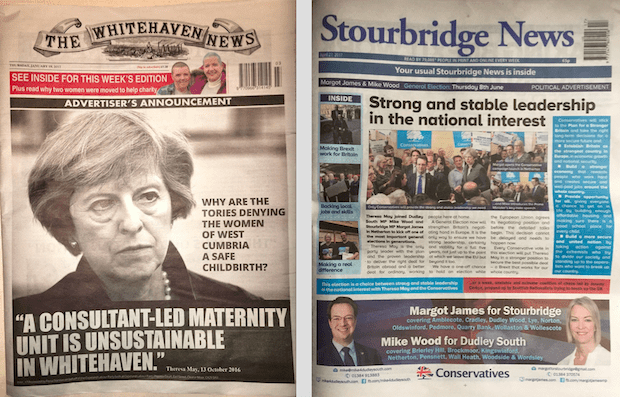Newspapers everywhere are in trouble, with advertising revenues down about 20 per cent a year. Local newspapers are worst hit and many are on the brink of collapse, sacking staff and pages. But there can be no more depressing sign of their distress than to see newspaper owners selling front pages to political parties.
Look at the above pictures: both are designed to deceive the reader and look like genuine front pages. They’re created by Labour and Conservative spin doctors, printed as so-called “cover wrap” adverts. Sure, there’s a blink-and-you-miss-it caveat saying “political advertisement” in the Labour one (left) for the Copeland by-election, there’s hardly any branding at all. The aim is to create a fake newspaper cover, using a headline and picture as a newspaper does. The aim is to deceive. To dress up propaganda as news: or, as to give this technique its proper name, fake news.
Until very recently, no newspaper company would have dreamt of handing its entire front page over to a political party on any day, let alone polling day. To be sure, papers do offer page-one endorsements of political parties – but it’s a big decision and almost always a decision based on which party’s agenda most relates to their readers’ instincts. Now, the Tories seem to have pioneered a new trick: writing their own front-page endorsements, and paying newspapers to run them. While Labour has tried this tactic, and Lib Dems did it ahead of the EU referendum, it seems the Tories have the biggest budget for “fake news” front pages on election day. This also lets the party circumvent local election spending rules as the splurge is categorised as national election spend.

The collapse of the print advertising market means that papers (especially local ones, who derive most of their income from advertising) have had to to go to ever-greater lengths to secure funding. Using the front page as advertising space is, in a way, a return to the days when every newspaper had small adverts on their front page. But now, a single client can pay for a front-page takeover. Usually, it’s glaringly obvious that it’s an advert: it will be for a car, perfume or somesuch.
But in recent months, we’ve been seeing advertorial – adverts, dressed up as journalism – under the masthead. It will break the hearts of the editors to have to run propaganda from political parties on their front page, but editors often don’t have much control over the situation. The client, in most cases the Tories, will have written what will probably be the largest cheque their bosses will receive that year. And papers, many of whom are on the brink of collapse, often feel they just can’t turn down that kind of money. So you end up with the sickening spectacle of fake news, designed by political parties, on front pages on polling day. Here’s a Lib Dem version ahead of the EU referendum
The worst of it is that, once elected, politicians pretend to be very worried about “fake news” saying this kind of thing is perpetrated by wicked Russians. Theresa May has said that Britain is offering support to Eastern Europe to “counter the disinformation campaign”. As soon as she has finished with her own propaganda campaign, that is.
It is tragic that local newspapers have been reduced to selling front pages to politicians, but it’s a grim reflection of the murderous market conditions. This also underlines the risk posed to press freedom. Now and again, politicians pretend take a great interest in the standards of the press (Leveson, etc) and propose a system (like Max Mosley’s ‘Impress’) that creates a regulatory hierarchy, with politicians at the top. They sense, rightly, that the press has never been weaker.
Ministers also profess to be very worried about fake news. But this election shows show how their main interest is, and always will be, the manipulation of the news to their own ends. It is the job of a free press to counteract this, but a free press needs money. When the money comes from politicians, the results are hideous. Some examples below.














Comments